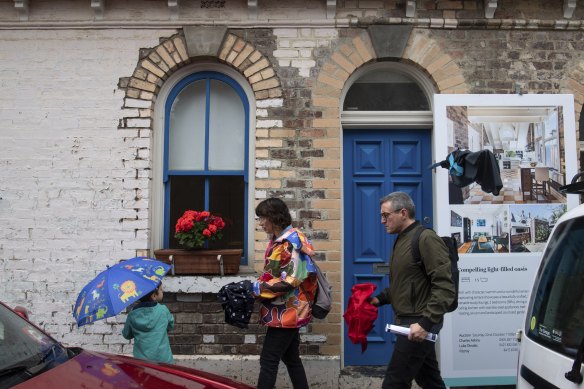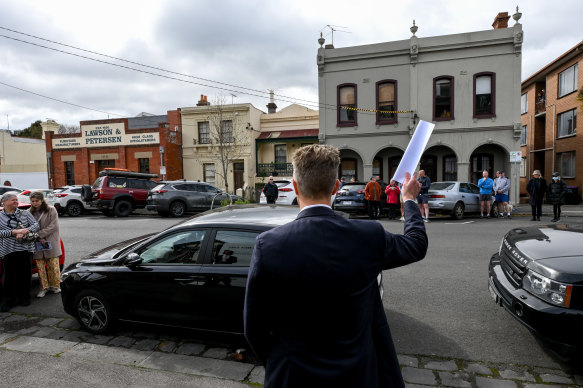This was published 2 years ago
Households on $200k a year offered help to buy a home
Experts have backed the idea of the Victorian government co-purchasing properties with home buyers, but warn its policy offers help to high-income households and could put upward pressure on house prices.
The Victorian government announced an extension to its Victorian Homebuyer Fund, which allows home buyers to purchase with a 5 per cent deposit. The government buys a stake of up to 25 per cent in the home, allowing home buyers to purchase with a smaller deposit and smaller mortgage repayments.

Home buyers can co-purchase with the Victorian government to get into home ownership.Credit: Penny Stephens
So far 2000 home buyers have used the program and another 1000 are approved, while a new $1.1 billion commitment will add another 7000 places.
A buyer must not own another property at the time of purchase, but may have in the past. Income caps for the scheme are $128,000 a year for individuals or $204,800 for joint applicants, while home price caps are $950,000 in Melbourne and Geelong or $600,000 in regional Victoria.
Grattan Institute economic policy program director Brendan Coates said there is a place for shared equity programs, especially to help older Australians who rent but will not work long enough to pay down a mortgage, or separating couples.
About 60,000 renting households aged 45-64 have assets outside super of more than $200,000 for singles or $300,000 for couples, and could buy a home through shared equity and pay off the loan balance with super at retirement, he said.
But an income cap of $128,000 a year was too broad, he said.
“That’s not targeting the support at those who genuinely need it, and you increase the risk the scheme ends up being inflationary to house prices,” he said.
“Prices in the long term will end up being higher than they otherwise would be. That doesn’t mean prices won’t fall in the short term when interest rates are rising but it does mean higher prices than would otherwise be the case.”
He added there was an open question about whether it was better to consolidate the upcoming federal shared equity scheme with different version run by the states.
Another option the state government should pursue is relaxing planning rules to allow more homes to be built in sought-after areas, he said.
University of Melbourne affordable housing expert Dr Katrina Raynor said she supports shared equity schemes in general, especially when targeted at lower-income earners.
“At $128,000 for an individual you’re not targeting a low-income household,” she said.
“Shared equity, particularly at that scale, is an example of an inflationary housing policy because you’re stimulating demand without stimulating supply.”

Another 7000 places in the shared equity scheme will be made available.Credit: Eddie Jim
She said it would help young people who did not have access to the Bank of Mum and Dad to achieve home ownership, but did not target households most in need of support.
Ordinarily it made better sense to tie shared equity schemes to new housing supply, but that would not be the best plan in this environment of shortages in building materials and labour.
The announcement comes in the wake of research that found Australian governments spent more than $20.5 billion on first home buyer help in the past decade, often cash grants and stamp duty concessions, which made housing affordability worse by driving up property prices.
The author of that report, senior research fellow in the City Futures Research Centre at the University of NSW, Dr Chris Martin, said shared equity was “a bit of an advantage” on traditional first home buyer grants.
At least in a shared equity scheme, the government’s contribution is repaid later, he said.
But there would still be a degree of inequality in the housing market because some home owners would have to repay their assistance, while others would be lucky enough to receive gifts from the Bank of Mum and Dad, he said.
“Unless governments are doing something more to restrain house price increases, that problem of rising inequality through the housing system - it’s still a problem,” he said.
“Policy measures that restrain spending on housing by households who already have a position in the system, they’re the things that governments have been less inclined to touch, but they’re the things that would make it less unequal,” he added, citing a broad-based land tax or macroprudential policy to limit investors.
He said the high income caps reflected that the mortgage serviceability requirements would be high for such a purchase.
“We should be more concerned about the very large number of people who don’t have $500 in savings,” he said.
“That reflects where house prices have gone and how far out of reach they are for so many households.”